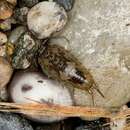en
names in breadcrumbs


"Budde-Lund, from whom the reference to Roux is taken, gives a full synonymy. The single specimen in the present collection was a female without the uropods, the fiagellum of the second antennae having about thirty-eight joints, the telsonic segment agreeing well with Dana's figure of that part in the species which he names 'Lyg. gaudichaudii?,' adopting the specific name from Milne-Edwards. Budde-Lund puts both the French author's and Dana's names in the synonymy of L. exotica." (Stebbing, 1904)
"Lagoon, Minikoi. Taken along with Sphaeroma [Exosphaeroma ?] globicauda. " (Stebbing, 1904)
Ligia is a genus of isopods, commonly known as rock lice or sea slaters. Most Ligia species live in tidal zone cliffs and rocky beaches, but there are several fully terrestrial species which occur in high-humidity environments.
Coastal Ligia species exhibit a mixture of terrestrial and marine characteristics, drying out easily, needing moist air and proximity to water to retain water. While they have gills and can exchange gas under water, they only do so when escaping terrestrial predators or being dislodged by wave action. They do not move swiftly in the water and are open to marine predation. They are well adapted to rocky surfaces and avoid sand, which opens them to terrestrial predation and desiccation.[1]
It has been suggested that Ligia is more closely to marine isopods than it is to true woodlice.[2][3]
Species separation is at times difficult because of sexual dimorphism. For example, males usually have longer and wider antennae than females. The males also tend to be larger but narrower, with the difference sometimes attributed to the female's brood pouch.[4] Complicating matters is the possible existence of cryptic species in the genus.[5]
This is a list of all Ligia species contained in A Bibliography of Terrestrial Isopods:[6][7]
Ligia is a genus of isopods, commonly known as rock lice or sea slaters. Most Ligia species live in tidal zone cliffs and rocky beaches, but there are several fully terrestrial species which occur in high-humidity environments.